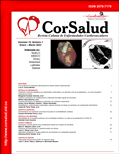Fibrilación ventricular idiopática por extrasístoles ventriculares con intervalo corto de acoplamiento: ¿un nuevo fenotipo? Experiencia cubana
Resumen
Introducción: La fibrilación ventricular idiopática desencadenada por extrasístoles ventriculares con intervalo corto de acoplamiento ha sido estudiada desde hace años, recientemente se ha propuesto como un nuevo fenotipo: short-coupled idiopathic ventricular fibrillation (sc-IVF), en inglés.
Objetivo: Describir la evolución clínica y electrocardiográfica de pacientes con sc-IVF.
Método: Se realizó un estudio descriptivo de pacientes con sc-IVF. Se excluyeron otras enfermedades que pudieran originar fibrilación ventricular (canalopatías y entidades eléctricas específicas). Se consideró extrasístole con intervalo corto de acoplamiento aquel menor o igual a 300 ms, localizada en la rama ascendente o cima de la onda T, en su rama descendente y algunas "not-so-short".
Resultados: Se estudiaron 12 sujetos sin cardiopatía estructural demostrable por métodos convencionales y sc-IVF. La edad promedio fue de 37,9 años (mínima 15, máxima 60), 6 pacientes del sexo femenino y 6 del masculino. El debut en todos los casos fue la muerte súbita por fibrilación ventricular, en seis se asoció torsión de puntas. La localización de la extrasístole pudo variar en un mismo paciente (se tomó el menor valor); predominó en la rama ascendente o en la cima de la onda T (66.6%, valor mínimo 220 ms). Hubo cuatro casos con intervalo "not- so-short". Dos pacientes fallecieron, ambos sin cardioversor desfibrilador automático implantable.
Conclusiones: La sc-IVF, constituye un nuevo fenotipo dentro del espectro de las arritmias ventriculares malignas. A intervalos más cortos, mayor malignidad. Es frecuente la asociación con torsión de puntas.Descargas
Citas
1. Belhassen B, Tovia-Brodie O. Short-Coupled Idiopathic Ventricular Fibrillation: A Literature Review With Extended Follow-Up. JACC Clin Electrophysiol. 2022;8(7):918-36. DOI: https://doi.org/10.1016/j.jacep.2022.04.013
2. Steinberg C, Davies B, Mellor G, Tadros R, Laksman ZW, Roberts JD, et al. Short-coupled ventricular fibrillation represents a distinct phenotype among latent causes of unexplained cardiac arrest: a report from the CASPER registry. Eur Heart J. 2021;42(29):2827-38. DOI: https://doi.org/10.1093/eurheartj/ehab275
3. Crea F. Towards precision medicine in the prediction of sudden cardiac death. Eur Heart J. 2021;42(29):2805-7. DOI: https://doi.org/10.1093/eurheartj/ehab476
4. Almehairi M, Alshiekh-Ali AA, Alfagih A. Idiopathic short-coupled ventricular tachyarrhythmias: Systematic review and validation of electrocardiographic indices. Egypt Heart J. 2018;70(4):301-6. DOI: https://doi.org/10.1016/j.ehj.2018.06.003
5. van der Ree MH, Postema PG. What's in a name? Further classification of patients with apparent idiopathic ventricular fibrillation. Eur Heart J. 2021;42(29):2839-41. DOI: https://doi.org/10.1093/eurheartj/ehab382
6. Haïssaguerre M, Shoda M, Jaïs P, Nogami A, Shah DC, Kautzner J, et al. Mapping and ablation of idiopathic ventricular fibrillation. Circulation. 2002;106(8):962-7. DOI: https://doi.org/10.1161/01.cir.0000027564.55739.b1
7. Dorantes Sánchez M, Ponce Paredes EF. Extrasístoles ventriculares con intervalo corto de acoplamiento: Su trascendencia. CorSalud [Internet]. 2015 [citado 10 Oct 2022];7(4):253-7. Disponible en: https://revcorsalud.sld.cu/index.php/cors/article/view/72
8. Dorantes Sánchez M, Ponce Paredes E, Falcón Rodríguez R. Extrasístoles ventriculares con intervalo corto de acoplamiento como detonantes de arritmias malignas. CorSalud [Internet]. 2016 [citado 10 Oct 2022];8(3):144-52. Disponible en: https://revcorsalud.sld.cu/index.php/cors/article/view/134
9. Dorantes Sánchez M, Cruz Cardentey M, Castro Hevia J, Castañeda Chirino O, Martínez López F, Falcón Rodríguez R. Muerte súbita arrítmogénica en sujetos sin cardiopatía estructural demostrable por métodos convencionales. Rev Cuban Cardiol [Internet]. 2021 [citado 12 Oct 2022];27(3):e1133. Disponible en: https://revcardiologia.sld.cu/index.php/revcardiologia/article/view/1133/pdf
10. Dorantes Sánchez M, López Delgado A. Fibrilación ventricular idiopática: un diagnóstico “deslizante”. Parte II. Rev Cuban Cardiol [Internet]. 2011 [citado 12 Oct 2022];17(3):209-17. Disponible en: https://revcardiologia.sld.cu/index.php/revcardiologia/article/view/89/76
11. Leenhardt A, Glaser E, Burguera M, Nürnberg M, Maison-Blanche P, Coumel P. Short-coupled variant of torsade de pointes. A new electrocardiographic entity in the spectrum of idiopathic ventricular tachyarrhythmias. Circulation. 1994;89(1):206-15. DOI: https://doi.org/10.1161/01.cir.89.1.206
12. Dorantes M, Marrero R, Méndez A, Castro J, Vázquez A. Historia familiar de muerte súbita por fibrilación ventricular idiopática. Arch Cardiol Mex. 2014;84(1):57-9. DOI: https://doi.org/10.1016/j.acmx.2013.05.007
13. Steinberg C, Krahn AD. Quinidine vs. ICD therapy in short-coupled ventricular fibrillation-is a randomized trial the next logical step? Eur Heart J. 2021;42(38):3993-4. DOI: https://doi.org/10.1093/eurheartj/ehab614
14. Belhassen B. Quinidine vs. ICD in patients with short-coupled idiopathic ventricular fibrillation: a call for a multicenter randomized trial. Eur Heart J. 2021;42(38):3992. DOI: https://doi.org/10.1093/eurheartj/ehab549
15. Belhassen B, Shauer A. Nine reasons for performing an electrophysiology study in patients with apparently idiopathic ventricular fibrillation. Heart Rhythm. 2022;19(7):1212-3. DOI: https://doi.org/10.1016/j.hrthm.2022.03.010
16. Anderson RD, Kumar S, Kalman JM, Sanders P, Sacher F, Hocini M, et al. Catheter Ablation of Ventricular Fibrillation. Heart Lung Circ. 2019;28(1):110-22. DOI: https://doi.org/10.1016/j.hlc.2018.09.005
17. Haissaguerre M, Cheniti G, Hocini M, Sacher F, Ramirez FD, Cochet H, et al. Purkinje network and myocardial substrate at the onset of human ventricular fibrillation: implications for catheter ablation. Eur Heart J. 2022;43(12):1234-47. DOI: https://doi.org/10.1093/eurheartj/ehab893
Descargas
Publicado
Cómo citar
Número
Sección
Licencia
Aquellos autores/as que tengan publicaciones con esta revista, aceptan los términos siguientes:- Los autores/as conservarán sus derechos de autor y garantizarán a la revista el derecho de primera publicación de su obra, el cuál estará simultáneamente sujeto a la Licencia de reconocimiento de Creative Commons que permite a terceros compartir la obra siempre que se indique su autor y su primera publicación esta revista.
- Los autores/as podrán adoptar otros acuerdos de licencia no exclusiva de distribución de la versión de la obra publicada (p. ej.: depositarla en un archivo telemático institucional o publicarla en un volumen monográfico) siempre que se indique la publicación inicial en esta revista.










